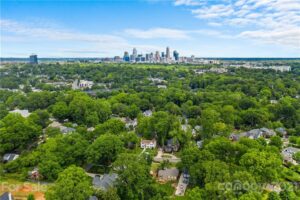 Charlotte’s housing market has exploded in recent years, bringing with it an array of new master-planned neighborhoods and luxury subdivisions. From resort-style pools to fitness centers, dog parks, and co-working lounges, modern developments are competing to deliver more comfort and community than ever before.
Charlotte’s housing market has exploded in recent years, bringing with it an array of new master-planned neighborhoods and luxury subdivisions. From resort-style pools to fitness centers, dog parks, and co-working lounges, modern developments are competing to deliver more comfort and community than ever before.
But as many homeowners have discovered, those amenities don’t come without strings attached. While developers highlight them as “included” lifestyle perks, the real costs often show up later, in the form of rising dues, special assessments, or increased maintenance budgets.
And as more communities rely on professional HOA managers to oversee these amenities, understanding what you’re actually paying for, and how to plan for it, has never been more important for Charlotte residents.
When Luxury Becomes a Line Item
In Charlotte’s booming suburbs, from Ballantyne to Huntersville, amenities have become essential selling points. Buyers expect neighborhood pools, walking trails, clubhouses, playgrounds, and manicured green spaces. These features boost curb appeal and property value, but they also come with recurring expenses that can quietly add up.
Every shared facility in a neighborhood has ongoing costs: cleaning, landscaping, insurance, security, and long-term replacement. A single pool pump or playground repair can run thousands of dollars, and when equipment ages, those costs multiply.
Many homeowners don’t think about that reality until their HOA board announces a dues increase or special assessment to cover repairs. For families on tight budgets, even a small fee hike can make a difference.
The Charlotte Trend: Bigger Communities, Bigger Budgets
As Charlotte continues to grow, developers are building large-scale, amenity-rich communities that appeal to modern buyers seeking “live-work-play” environments. According to local market reports, the region has seen double-digit growth in new subdivisions that include resort-style features once reserved for private clubs.
While this evolution has reshaped the city’s residential landscape, it’s also introduced complexity. More amenities mean more vendors, more maintenance, and greater administrative oversight. That’s why community associations often turn to professional management firms for help.
These firms handle vendor contracts, budget forecasting, and maintenance scheduling, ensuring that the community remains both functional and financially stable. Yet even the best-run communities must balance resident expectations with realistic operating costs.
Understanding How HOA Budgets Work
Every HOA operates on an annual budget funded by homeowner dues. That budget covers essential services, landscaping, utilities, pest control, and insurance, as well as future maintenance for shared assets.
A portion of each homeowner’s payment goes into a reserve fund, which acts as a safety net for large future expenses: roof replacements, pool resurfacing, or playground upgrades. If reserves are underfunded, the community risks special assessments, one-time charges to cover big repairs.
National data underscores the stakes: U.S. homeowners’ association fees have risen about 5–7% per year on average, according to research compiled by iPropertyManagement. As inflation and maintenance costs continue climbing, even well-planned budgets are under pressure.
For Charlotte’s newer neighborhoods, these costs are amplified by amenities designed to impress, heated pools, sports courts, or event spaces that require ongoing upkeep.
What Homeowners Can Do to Stay Ahead
1. Read the Fine Print Before You Buy
Before closing on a new home, review the HOA’s financial statements, reserve studies, and bylaws. Check how fees have changed over time, whether the association carries adequate reserves, and what amenities are covered under your dues.
2. Attend HOA Meetings
Most homeowners rarely attend board meetings, until something goes wrong. Staying involved helps you understand where funds are going and gives you a voice in future planning.
3. Plan for Increases
Even the best-run associations will raise fees periodically. Budget for incremental increases rather than treating your dues as a fixed cost. A proactive approach makes those adjustments less stressful.
4. Support Preventive Maintenance
It’s often cheaper to maintain than to replace. Encouraging regular inspections, landscaping refreshes, and minor repairs keeps long-term expenses in check.
5. Encourage Transparency
Ask your board to communicate clearly about upcoming projects and potential expenses. Transparency builds trust and helps prevent resentment when costs rise.
The Role of Professional Management
For larger or fast-growing communities, volunteer HOA boards can easily become overwhelmed. Managing multiple contractors, service schedules, and regulatory requirements takes time, and mistakes can be costly.
That’s where professional management firms make a measurable difference. Experienced HOA managers create realistic budgets, coordinate vendors, and monitor reserves to ensure that amenities enhance property values instead of draining them.
Their involvement often saves homeowners money in the long run by reducing inefficiencies, negotiating better service contracts, and preventing small issues from turning into major expenses.
Balancing Amenities and Affordability
Charlotte’s attraction lies in its balance, urban convenience with suburban comfort. But for homeowners, maintaining that balance means being mindful about how lifestyle upgrades affect affordability.
When communities prioritize amenities over sustainability, financial strain follows. On the other hand, when boards, residents, and management teams work together, amenities can elevate both quality of life and long-term property values.
The next time you tour a neighborhood with a gleaming pool, a fitness center, or a clubhouse that feels like a resort, pause for a moment. Behind every convenience is a cost, and behind every thriving community is careful planning.
As Charlotte’s housing boom continues, homeowners who stay informed, proactive, and engaged in how their associations operate will not only protect their budgets but also preserve the lifestyle that makes their neighborhood special.
Because in the Queen City, good amenities add beauty, but smart budgeting keeps that beauty sustainable.


